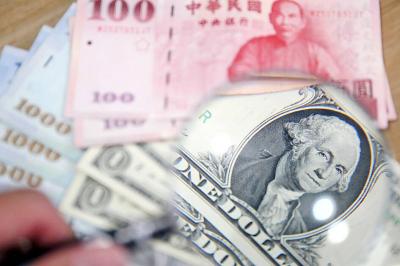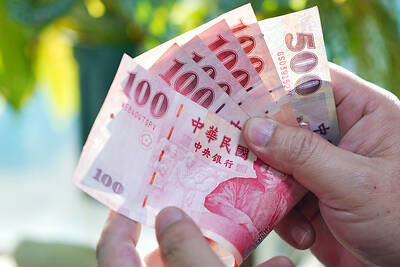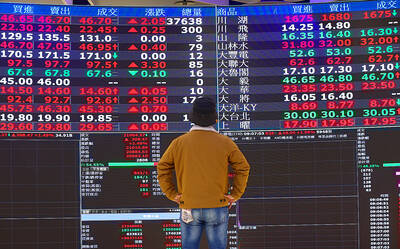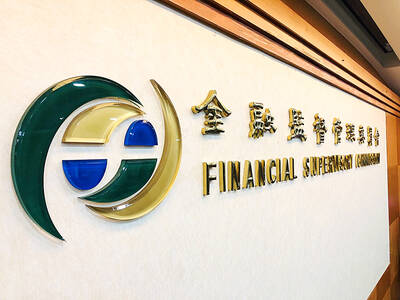The government’s business climate monitor last month returned a second “yellow-red” signal, indicating that the nation’s export-oriented economy remained healthy, but is likely shifting gears, the National Development Council (NDC) said yesterday.
The monitor lost two points to 32, the brink of the “yellow-red” territory, dragged by industrial production weakness attributable to lackluster sales of metal products and poor demand for petrochemical products, the council said.
The council measures economic health using a five-color system, with blue signaling a recession, green suggesting steady growth and red indicating a boom. Dual colors of yellow-red and yellow-blue mean that the economy is changing gears to a better or worse state.

Photo: CNA
“We remain guardedly optimistic about the economy and will closely monitor any disrupting signs,” NDC Economic Department Director Chiu Chiu-ying (邱秋瑩) said, adding that the disappointing industrial output also had to do with two typhoons that disrupted shipments.
Local electronics suppliers continued to benefit from the artificial intelligence (AI) boom, while non-tech firms remained hit by a global slowdown induced by monetary tightening in the US and Europe, the official said.
The index of leading indicators, which seeks to foretell the economic scene in the next six months, declined 0.47 percent to 101.84, the council said.
The reading came after construction floor spaces, business confidence, labor accession and monetary supply displayed negative cyclical movements, it said.
The central bank’s selective credit controls introduced in September appeared effective in cooling the housing fever, it said.
In contrast, the gauges on imports of semiconductor equipment, export orders and local shares picked up to reflect healthy momentum, it said.
The coincident indicators, which mirror existing economic situations, held largely flat with a 0.004 percent decline to 104.1, the council said.
The measures on utility use as well as retail, wholesale and restaurant revenues weakened, but exports, overtime hours, manufacturing sales, and imports of machinery and electrical equipment gained value, it said.
Major global research bodies recently raised their forecast for the world’s GDP growth next year, favorable for global trade and Taiwan’s exports, the council said.
A stronger global economy would lend support to end-market demand for goods and services, it said.
Furthermore, major US technology giants have indicated they would spend more money on developing AI applications next year, a megatrend that would translate into active business growth for Taiwanese firms on the AI supply chain, it said.
However, Taiwan needs to watch out for uncertainty linked to geopolitical tensions, and US-China technology competition and trade disputes, it said.

The US dollar was trading at NT$29.7 at 10am today on the Taipei Foreign Exchange, as the New Taiwan dollar gained NT$1.364 from the previous close last week. The NT dollar continued to rise today, after surging 3.07 percent on Friday. After opening at NT$30.91, the NT dollar gained more than NT$1 in just 15 minutes, briefly passing the NT$30 mark. Before the US Department of the Treasury's semi-annual currency report came out, expectations that the NT dollar would keep rising were already building. The NT dollar on Friday closed at NT$31.064, up by NT$0.953 — a 3.07 percent single-day gain. Today,

‘SHORT TERM’: The local currency would likely remain strong in the near term, driven by anticipated US trade pressure, capital inflows and expectations of a US Fed rate cut The US dollar is expected to fall below NT$30 in the near term, as traders anticipate increased pressure from Washington for Taiwan to allow the New Taiwan dollar to appreciate, Cathay United Bank (國泰世華銀行) chief economist Lin Chi-chao (林啟超) said. Following a sharp drop in the greenback against the NT dollar on Friday, Lin told the Central News Agency that the local currency is likely to remain strong in the short term, driven in part by market psychology surrounding anticipated US policy pressure. On Friday, the US dollar fell NT$0.953, or 3.07 percent, closing at NT$31.064 — its lowest level since Jan.

The New Taiwan dollar and Taiwanese stocks surged on signs that trade tensions between the world’s top two economies might start easing and as US tech earnings boosted the outlook of the nation’s semiconductor exports. The NT dollar strengthened as much as 3.8 percent versus the US dollar to 30.815, the biggest intraday gain since January 2011, closing at NT$31.064. The benchmark TAIEX jumped 2.73 percent to outperform the region’s equity gauges. Outlook for global trade improved after China said it is assessing possible trade talks with the US, providing a boost for the nation’s currency and shares. As the NT dollar

The Financial Supervisory Commission (FSC) yesterday met with some of the nation’s largest insurance companies as a skyrocketing New Taiwan dollar piles pressure on their hundreds of billions of dollars in US bond investments. The commission has asked some life insurance firms, among the biggest Asian holders of US debt, to discuss how the rapidly strengthening NT dollar has impacted their operations, people familiar with the matter said. The meeting took place as the NT dollar jumped as much as 5 percent yesterday, its biggest intraday gain in more than three decades. The local currency surged as exporters rushed to